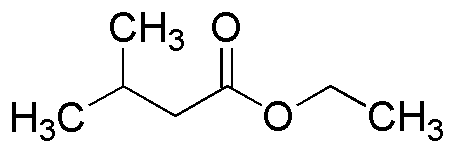Ethyl isovalerate is widely utilized in research focused on:
- Flavoring and Fragrance Industry: This compound is commonly used as a flavoring agent in food products and beverages, providing a fruity aroma reminiscent of apples and pears. Its pleasant scent makes it a popular choice in perfumes and scented products.
- Pharmaceutical Applications: Ethyl isovalerate serves as an intermediate in the synthesis of various pharmaceuticals, enhancing the efficacy and stability of active ingredients in medications.
- Agricultural Chemicals: It is utilized in the formulation of pesticides and herbicides, where it can improve the delivery and effectiveness of active compounds, thus supporting sustainable agricultural practices.
- Cosmetic Products: The compound is often included in cosmetic formulations for its aromatic properties, contributing to the overall sensory experience of lotions, creams, and other personal care items.
- Research and Development: In academic and industrial laboratories, ethyl isovalerate is used as a standard in analytical chemistry, aiding in the calibration and validation of various analytical techniques.
General Information
Properties
Safety and Regulations
Applications
Ethyl isovalerate is widely utilized in research focused on:
- Flavoring and Fragrance Industry: This compound is commonly used as a flavoring agent in food products and beverages, providing a fruity aroma reminiscent of apples and pears. Its pleasant scent makes it a popular choice in perfumes and scented products.
- Pharmaceutical Applications: Ethyl isovalerate serves as an intermediate in the synthesis of various pharmaceuticals, enhancing the efficacy and stability of active ingredients in medications.
- Agricultural Chemicals: It is utilized in the formulation of pesticides and herbicides, where it can improve the delivery and effectiveness of active compounds, thus supporting sustainable agricultural practices.
- Cosmetic Products: The compound is often included in cosmetic formulations for its aromatic properties, contributing to the overall sensory experience of lotions, creams, and other personal care items.
- Research and Development: In academic and industrial laboratories, ethyl isovalerate is used as a standard in analytical chemistry, aiding in the calibration and validation of various analytical techniques.
Documents
Safety Data Sheets (SDS)
The SDS provides comprehensive safety information on handling, storage, and disposal of the product.
Product Specification (PS)
The PS provides a comprehensive breakdown of the product’s properties, including chemical composition, physical state, purity, and storage requirements. It also details acceptable quality ranges and the product's intended applications.
Certificates of Analysis (COA)
Search for Certificates of Analysis (COA) by entering the products Lot Number. Lot and Batch Numbers can be found on a product’s label following the words ‘Lot’ or ‘Batch’.
*Catalog Number
*Lot Number
Certificates Of Origin (COO)
This COO confirms the country where the product was manufactured, and also details the materials and components used in it and whether it is derived from natural, synthetic, or other specific sources. This certificate may be required for customs, trade, and regulatory compliance.
*Catalog Number
*Lot Number
Safety Data Sheets (SDS)
The SDS provides comprehensive safety information on handling, storage, and disposal of the product.
DownloadProduct Specification (PS)
The PS provides a comprehensive breakdown of the product’s properties, including chemical composition, physical state, purity, and storage requirements. It also details acceptable quality ranges and the product's intended applications.
DownloadCertificates of Analysis (COA)
Search for Certificates of Analysis (COA) by entering the products Lot Number. Lot and Batch Numbers can be found on a product’s label following the words ‘Lot’ or ‘Batch’.
*Catalog Number
*Lot Number
Certificates Of Origin (COO)
This COO confirms the country where the product was manufactured, and also details the materials and components used in it and whether it is derived from natural, synthetic, or other specific sources. This certificate may be required for customs, trade, and regulatory compliance.

